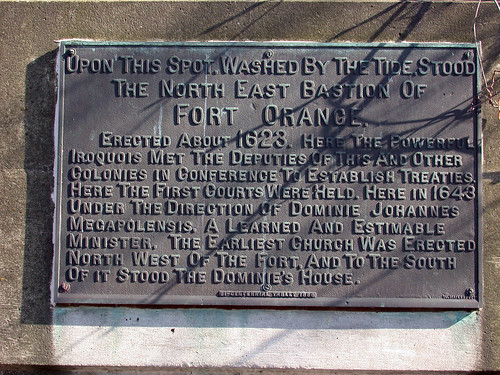Bi-Centennial Tablets
No, not the bicentennial with the quarters and the barges – Albany celebrated the bi-centennial of its charter as a city (which came some 65 years after the initial settlers) in 1886. Celebrations were done in high style then, and for this one, 42 historic tablets were placed around the city to remind us of our past. Some of these tablets still exist, some have disappeared. I would have thought that this one, Tablet No. 1, had disappeared, having never seen it, but a fellow Flickrite recently posted a photo of it and was good enough to share its location, on a wall among the tangles of highway, just down Broadway from the remodeled Holiday Inn Express, under one of the Dunn/I-787 flyovers. Its original location was “fifty feet east of the bend in Broadway, at Steamboat square,” on a granite block “with a slanting top to shed water and surrounded by an iron railing for protection.” The tablet, like its surroundings, has come down in the world, but at least it’s still there, reminding us.
“Upon this spot, washed by the tide, stood the north east bastion of Fort Orange. Erected about 1623. Here the powerful Iroquois met the deputies of this and other colonies in conference to establish treaties. Here the first courts were held. Here in 1643 under the direction of Dominie Johannes Megapolensis, a learned and estimable minister, the earliest church was erected north west of the Fort and to the south of it stood the dominie’s house.”
My Dutch friend tells me the spelling was and is “dominee,” but all the histories here have it as “dominie;” Megapolensis was a Hellenization, quite the style at the time, of the family name, Van Mekelenburg. He was the first clergyman of the Dutch Church here in Albany, and after his posting here went on to New Amsterdam.


![Reblog this post [with Zemanta]](http://img.zemanta.com/reblog_e.png?x-id=4eb8fd05-3d04-4883-a80b-d125b717bb16)